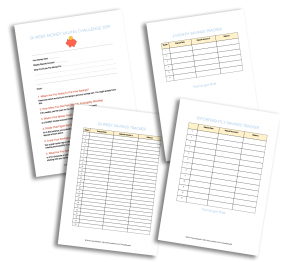It’s approximately 26 weeks until the end of the year and 2019 will be over. Whether you want to save for Christmas or just want to bolster that sad savings account up to a few thousand, let’s start now and aim for an extra $2,000 by the end of the year.
I’m sure you’ve seen all of those money savings challenges online, but let’s take it one step further and actually get this done.
Download Free Printables
If you need them, I’ve created some free PDF printables to help you with this money savings challenge. I have one for 26 weeks, 13 fortnightly, and 6 months.

They are all the same except for the chart to fill in, which is either 26 weeks, 13 fortnight, or 6 months.
Download your preferred option here:
Click the link to open in a browser window, or right click to save the file to your computer.
I hope you find them useful 🙂
Create Your Money Saving System
1. Where Are You Going To Put Your Savings?
Do you have a savings account that you are going to put that money? Don’t use your regular old zero-interest bank account. You want something with interest. Although good luck finding anything decent now that the Reserve Bank has lowered interest rates yet again. Low-interest rates are great for borrowing but terrible for savings.
The best you can probably do now is about 2% p.a. but it’s more likely that you’ll get something like 1.5%. Makes the stock market look a little more attractive doesn’t it. 😉
Anyway, decide where you are going to squirrel away those savings. If you already have a high-interest savings account, use that, if not, open one up – you should have one anyway for your emergency fund, etc, whether you’re doing the challenge or not.
2. How Often Do You Get Paid?
How often do you get paid? Weekly, Fortnightly, Monthly, Whenever? Whenever is going to be harder, but maybe not, people who get paid from client work or businesses or such are used to budgeting their money.
Anyway, every time you get paid you want to to transfer some out straight away. You can either do this automatically by setting it up with your bank or you might prefer to do it yourself. Do whichever way you like to do your finances.
3. What’s Your Money Goal?
Do you want to aim for $2,000? It’s a good amount. You could do more or less. Up to you. Try and stretch yourself, just a little bit to make it an actual challenge. Save more than you did last year.
You got your figure, cool. Let’s use $2,000 for the rest of the example but substitute in your own.
4. Divide That Figure By How Often You Get Paid
If you’re saving $2,000 and get paid weekly, that’s 26 weeks and $76.92 per week (round it up to $77).
If that’s fortnightly (so 13 pays) it’s $154 a fortnight. If it’s monthly (6 months) it’s $334 rounded up, per month.
You figure out how much you need to put into the savings account every time you get paid.
If your income is variable – then you might not have a set figure perhaps you can use a % of whatever income you receive instead if that works.
5. Track Your Savings and Create Accountability.
Now you need to provide some way to track your savings. It’ll keep you accountable and more likely that you want to continue to reach the goal.
There are lots of ways you can do this. It can be as simple as using a goal or money tracker app on your phone.
You can make a progress bar in your bullet journal.
You can create a chart and pin it up somewhere or attach it to the fridge. Anything you think that will motivate you and keep you accountable.
I did go ahead and make some quick printables in case they would be useful to you. They aren’t fancy or anything, you could probably do better, but in case you’re time poor. They are at the top of this post.
6. What are you going to do with the money you save?
So what are you going to do with the money you save?
Are you saving for Christmas specifically or another end of year goal? Have a think about what you are going to do with the savings once you reach your savings goal.
The challenge is going to be much easier to achieve if you have an end vision of what the money is going to do.
You can spend it on Christmas if you want or an end of year holiday.
Or it could be the start of your Emergency Fund, or perhaps money to invest in stocks.
Whatever you choose to do with it, be proud that you were able to achieve what you set out to do with the money challenge. Doesn’t matter if it was a small amount or a big amount.
You got this.
Cover Photo Credit: Photo by Jordan Rowland on Unsplash


